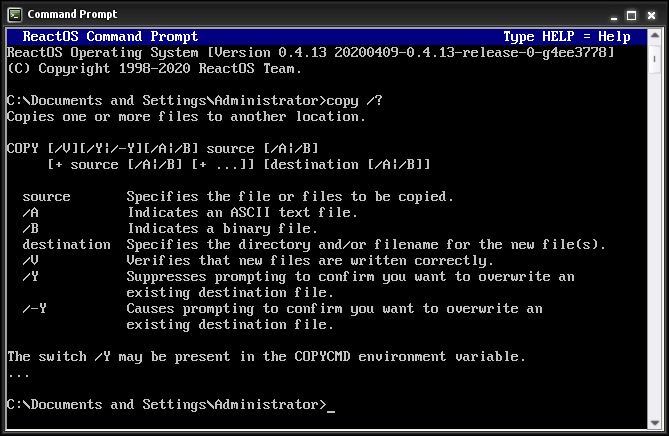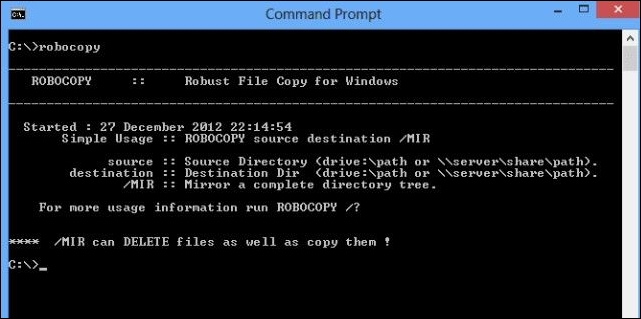Transferring the files in Windows is a basic need that can be accomplished using different command line tools. Some of these are copied XCopy, and Robocopy commands line tools. However, even professional Windows users face issues when it comes to finding the best applications of these command lines along with their use cases.
Let us understand all about copy vs. Xcopy vs. Robocopy. Starting with the quick definitions of copy, Xcopy, and Robocopy, it becomes easy to go through their availabilities and examples. It is easy to understand the differences between the three with a quick comparison table. Starting with the copy command first.
What Is Copy
Copy command is one of the popular commands used daily by multiple users. With a self-explanatory name, it copies data from one location to another. Let us know all details about copy command.
Definition
It is the basic command to copy files from one location to another. It is available in different operating systems and doesn't only make copies but can be used to combine multiple files into one file. The destination is the directory which then refers to the current working directory.

It can be used in text mode or binary mode. In text mode, the copy command stops at the "EOF" character, while in the binary mode, the files are accumulated completely and ignore the "EOF" characters.
It is easy to copy files to different devices. For example, the "copy file con" output the file to the screen console, "copy con file" considers the text typed into the console and puts it in "FILE".
Availability of Copy Command
It is available in text mode and binary mode in the following ways:
Text mode: The command for text mode is copy /a doc1.txt + doc2.txt doc3.txt and copy / a *.txt doc3. txt.
![]()
Binary mode: The command for binary mode is copy /b image1.jpg + image2. jpg image3. jpg.
![]()
Copy command options
Some of the standard copy command options are:
- It is supported by Tim Paterson's SCP 86-DOS as a "copy" command.
- It has been available since version 1 in IBM PC DOS/ MS-DOS.
- It is known as "cp" in the Unix command.
- In CP/M, the copy command is "PIP".
- In Stratus OpenVOS, it is familiar with the "copy_file" command.
What Is Xcopy
This Xcopy command helps create files with the specific archive attribute set irrespective of its location in the source file. It is widely used in operating systems like ReactDOS, FreeDOS, Microsoft Windows, IBM OS/2, MS-DOS, and IBM PC DOS.
Definition
This command is used to copy multiple files or complete directory trees from one directory to another. It is further used for copying files through different networks. "Xcopy" stands for extended copy and is created as a highly functional file copying feature like the "copy" command in different operating systems. It first appeared in DOS 3.2 and is now used in IBM PC DOS, MS-DOS, IBM OS/2, Microsoft Windows, FreeDOS, ReactDOS, etc.

Availability of Xcopy command
Xcopy command is available in:
- In Windows 10, Xcopy is in the Desktop operating system and Microsoft Windows Server.
- The DR DOS 6.0 and Datalight ROM-DOS have the "XCOPY" command, and its FreeDOS version is licensed under GPL.
- "Xcopy" has a Wine compatible version, licensed under the LGPL.
Xcopy command options
Some of the Xcopy command options are:
It creates a new directory by copying the existing directory contents. It includes different subdirectories or files in the hidden attributes and empty directories. It is Xcopy e:\existing e : \newcopy /e /i /h.
![]()
Using Xcopy when pathnames have spaces. It is Xcopy "D: \Documents and Settings\MY.USERNAME\My Documents\ *" "E:\MYBACKUP\My Documents\" /D/E/C/Y.
![]()
It can be used to copy entire data in the mapped network drive in the network restartable mode while ignoring the possible errors. It is Xcopy *.* z : \Netmirror /E /V /C /F /H /Y /Z 1>out.txt 2>err.txt.
![]()
It copies a single file from a directory or file without prompt. It is cmd /c echo F | Xcopy "c:\directory 1\myfile" " c:\directory 2\myfile".
![]()
What Is Robocopy
Also called "Robust File Copy", Robocopy is the file copy or command-line directory for Microsoft Windows. Let us know more about Robocopy in detail.
Definition
Robocopy replaces the Xcopy with advanced options. It was first released as the Windows NT 4.0 Resource Kit part. Currently, it is part of the Windows Server 2008 and Windows Vista. It has notable capabilities above and beyond the built-in Windows copy and Xcopy commands.

It can tolerate network interruptions and helps resume copy. Further, it is easy to choose the option to skip NTFS junction points causing copying failures due to infinite loops. Further, it can preserve original timestamps and copy file data or attributes precisely.
Robocopy examples
Some of the Robocopy examples are:
1. Copying the directory content. It is Robocopy "C : \Directory A" "C " \Directory B" /E.
![]()
2. Copying all the information in the directory recursively. It is Robocopy C:\A C:\B /COPYALL /E /R : 0 /DCOPY : T.
![]()
3. Mirroring files from A to B while destroying the files in B which are absent in A. It is Robocopy C:\A \\backupserver\B /MIR /Z.
![]()
Copy vs. Xcopy vs. Robocopy| What Are the Differences
After learning in detail about copy, Xcopy, and Robocopy, it comes down to understanding their key differences. Let us do a quick copy vs. Xcopy vs. Robocopy based on different features.
| Name | External or Internal | Command type | Data type |
|---|---|---|---|
| Copy | It is part of the internal command. | It is the basic command. | It can copy one or more files. |
| Xcopy | It is an external command. | It is the extended copy command. | It can copy the group of files to and from directories. |
| Robocopy | It is an external command. | It is the advanced Xcopy command. | It can copy multiple files across a network. |
Bonus Tip: Copy/Backup Files with Robocopy Alternative
The above three command lines are all file copying methods, occupying large space, so you can choose a better method - backup.
Sometimes backup is better because the backup is to "copy" files to a specified location by creating an image. Files are compressed, taking up less space and faster than direct copying. Therefore, you can select the backup method to "copy" or "transfer" files.
Common backup methods include Windows File History, backup software, or cloud backup(Google Drive, Dropbox, etc.). If you are looking for a simple and convenient backup method, EaseUS Todo Backup is a great choice, which can make flexible backup types, file backup, disk backup, system backup, and even external HDD backup. Even your files can be backed up to NAS, EaseUS cloud, and so on.
If an important file is accidentally deleted and there is no backup, don't worry. You can use the data recovery software to restore the deleted file.
Final Verdict
Hence, it is easy for beginners and professionals to understand the command line directories, i.e., copy, Xcopy, and Robocopy. Starting with the definitions, the "copy" command is used for copying files or data, and "Xcopy" is used to copy multiple files or complete directory trees from one directory to another, etc. Finally, "Robocopy" replaces "Xcopy" with various options.
After going through the availabilities, examples, and different commands for copy, Xcopy, and Robocopy, it is easy to differentiate between these three command lines. Based on the other features, it is easy to understand their fundamental differences, and professionals can find the best command based on their immediate needs. When it comes to copy vs. Xcopy vs. Robocopy, it is all about individual features and user requirements.
Was This Page Helpful?
Daisy is the Senior editor of the writing team for EaseUS. She has been working at EaseUS for over ten years, starting as a technical writer and moving on to being a team leader of the content group. As a professional author for over ten years, she writes a lot to help people overcome their tech troubles.
Brithny is a technology enthusiast, aiming to make readers' tech lives easy and enjoyable. She loves exploring new technologies and writing technical how-to tips. In her spare time, she loves sharing things about her game experience on Facebook or Twitter.
Related Articles
-
Fix: Operation Failed with Error 0x0000011b (Windows 10/11)
 Daisy/2024-01-11
Daisy/2024-01-11 -
Raid 6 vs Raid 10: Which is better in Speed and Security?
 Daisy/2024-11-27
Daisy/2024-11-27 -
Windows 11 Download: How to Download and Install Windows 11 [3 Ways]
 Cedric/2024-10-25
Cedric/2024-10-25 -
Breaking Records: New 100TB SSD Sets a New Standard for Data Storage
 Roxanne/2024-11-27
Roxanne/2024-11-27
